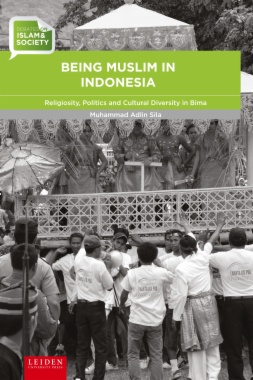How Muslims in Indonesia consider their religious practices, politics and culture as Islamic is described in this volume. By examining the various ways Bima Muslims constitute their Islamic identities and agencies through rituals and festivals, this book argues that religious practice is still vigorous in present Bima. It explores the reproduction of religious meanings among various local Muslims and the differences between social groups. Islam is represented as divided between the traditionalist Muslims and the reformist Muslims, between the royal family and the ordinary Muslims, and between Muslim clerics and lay people. Consequently, there is no single picture of Islam. As Bima Muslims construe their Islam in response to their surroundings, what it means to be a Muslim is constantly being negotiated. The complexity of religious life has been a result of the duality of socio-political settings in Bima which stems from the early period of the Islamization of Bima to the present.
- Table of Contents
- List of Illustrations
- Figure 1.1. Bima in the Indonesian archipelago
- Figure 2.1. The Malay Penghulu and dancers inside the litter are carried to the Bima palace by 99 people from Kampung Melayu to the Sultan palace
- Figure 2.2. The Malay Penghulu presenting al Qur’an to the Sultan, symbolizing the Sultan’s acceptance of Islam in Hanta Ua Pua festival
- Figure 2.3. The Location of Bima Municipality
- Figure 2.4. Map of Kampung Pane and Kampung Melayu
- Figure 3.1. The Bunga Bareka
- Figure 3.2. The Bunga Dolu
- Figure 4.1. Masjid Sultan Muhammad Salahuddin
- Figure 5.1. The entrance gateway and the Sultan palace (Asi Mbojo), lare-lare (1900-1940, Collection Tropenmuseum, part of the National Museum of World Cultures, Wikimedia Commons)
- Figure 5.2. Asi Kalende, the former palace of the Ruma Bicara, is now regarded as haunted by local people as it has been left untended for years
- Figure 5.3. Haji Kasimu healing a patient who had suffered from infertility for years on the terrace of a nearby mosque
- Figure 6.2. Rimpu parade at a carnival celebrating the anniversary of Bima on 5 July, 2012
- Figure 7.1. Henna night (Bim.: kapanca).
- Preface
- Acknowledgements
- Notes on Transliteration and Style
- Chapter One. Introduction
- 1.1. Why Bima is important?
- 1.2. Sultan and Raja Bicara: Dyadic Leadership
- 1.3. Being Muslim as Social Phenomena
- 1.4. Outline of the Book
- Chapter Two. Background to the Study
- 2.1. Previous Studies on Islam and Muslims in Bima
- 2.2. Methodological and Theoretical Framework
- 2.3. Bima as a Study Site
- 2.4. Choosing the field
- 2.5. Methods of collecting data
- Chapter Three. Hanta Ua Pua:
Delivering Betel and Accepting Islam
- 3.1. Historical accounts of the festival
- 3.2. Dato di Banda and Kampung Melayu
- 3.3. The celebration of the Prophet Muhammad’s birthday
- 3.4. Mawlid texts: the many versions of written words in praise of the Prophet
- 3.5. The Festival of Hanta Ua Pua
- 3.6. Majelis Hadat Dana Mbojo and Hanta Ua Pua: the Politics of Festival
- 3.7. The local dimensions of the NU and Muhammadiyah in Bima19
- 3.8. Conclusion
- Chapter Four. Imam and Royal Mosque
- 4.1. Imam and Sultan
- 4.2. Imam and Royal Foundation
- 4.3. Ritual prayer among Muslims in Bima
- 4.4. Social dimension of ritual prayers
- 4.5. Accommodation during Ramadan ritual prayers
- 4.6. The festival of breaking the fast: Idul Fitri
- 4.7. Friday congregational prayer: Regional by-laws and politics of ritual
- 4.8. Conclusion
- Chapter Five. Sando and Spirit Possession: Engaging with the Spirit and Healing the Sick
- 5.1. Sando, spirit possession and spirit mediumship
- 5.2. The local belief in supernatural beings and types of sickness
- 5.3. Religious reformism and the belief of ancestral spirits: from parafu ro pambora to padasa
- 5.4. The power of water and Qur’anic verses in healing rituals
- 5.5. Being submissive and healing the sick with the help of God: Karana ala
- 5.6. Protecting the village, interceding for salvation: doa dana
- 5.7. Healing practice and its relationship to Islamic mysticism
- 5.8. Fitua, Silsilah and the Seven Grades (Martabat Tujuh)
- 5.9. Conclusion
- Chapter Six. Life-Cycle Rituals:
Praying from the Unborn to the Newborn and Becoming Muslim
- 6.1. Concepts of solidarity in lifetime rituals
- 6.2. Ritual for pregnant mother
- 6.3. Birth delivery ritual
- 6.4. Hair-shaving and name-giving
- 6.5. Circumcision
- 6.6. Complete Qur’an recital and veiling
- 6.7. Conclusion
- Chapter Seven. Life-Cycle Rituals:
Marriage and Death, Getting Together in Joy and Sadness
- 7.1. Village gathering
- 7.2. Marriage ceremony
- 7.3. Bride-service at the potential parents-in-laws’ residence
- 7.4. Marriage payment delivery
- 7.5. Henna Night
- 7.6. Marriage contract ceremony
- 7.7. Commemoration of the deceased
- 7.8. Feasting and praying for the deceased
- 7.9. Conclusion
- Chapter Eight. Concluding Remarks
- 8.1. Religiosity
- 8.2. Politics
- 8.3. Cultural Diversity
- 8.4. Conclusion
- Appendix I. The List of Bima Sultans
- Appendix II. The List of Raja Bicara
- Glossary
- Notes
- Bibliography
- Index

